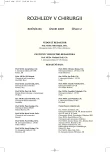Appendectomy – Comparison of Results of Laparoscopy versus Open Surgery
Authors:
M. Škrovina 1; R. Vaňko 1; S. Czudek 1; L. Adamčík 1; J. Bartoš 1; M. Velkoborský 2; I. Ivan Ferák 3
Authors‘ workplace:
Chirurgické oddělení, Onkocentrum J. G. Mendela a Nemocnice Nový Jičín, primář: MUDr. S. Czudek, CSc.
1; Radiodiagnostické oddělení, Onkocentrum J. G. Mendela a Nemocnice Nový Jičín, primář: MUDr. M. Velkoborský
2; Patologie, P&R LAB s. r. o., Onkocentrum J. G. Mendela a Nemocnice Nový Jičín, primář: MUDr. I. Ferák, Ph. D.
3
Published in:
Rozhl. Chir., 2007, roč. 86, č. 2, s. 92-96.
Category:
Monothematic special - Original
Overview
Aim:
The authors present results of laparoscopy versus open appendectomy in patients indicated for urgent procedures.
Materials and Methods:
214 patients, who underwent urgent appendectomy during a 18-month period (November 2004 – April 2006) were included in the retrospective study. The subjects were assigned to two main study groups according to the chosen abdominal approach – laparoscopic versus classical method. Within the respective study groups, duration of the procedure, histopathological findings, peroperative and postoperative complications, duration of postoperative hospitalization were assessed. Furthermore, in the laparoscopic subgroup, requirement for conversion to open surgery is assessed.
Results:
The results proved that the laparoscoic approach reduced hospitalization period in patients with histopathologicaly advanced findings. The positive effect of miniinvasive methods on hospitalization duration is diminished in subjects with less advanced findings.
Conclusion:
Considering overall benefits of the laparoscopic procedures, the authors themselves prefer the laparoscopic method as the method of choice in management of acute appendicitis.
Key words:
acute appendicitis – appendectomy – laparoscopy – complications
Sources
1. Sauerland, S. Acute Appendicitis – Update 2006. In: Neugebauer, E. A. M., Sauerland, S., Fingerhut, A., Millat, B., Buess, G.: EAES Guidelines for Endoscopic Surgery. Berlin: Springer Berlin Heidelberg, 2006, 387–390.
2. Semm, K. Die endoskopische Appendektomie. Gynekol. Prax., 1982, 7: s. 26.
3. Gryga, A. Laparoskopická apendektomie aresekce Meckelova divertiklu. In: Duda, M., Czudek, S.: Miniinvazivní chirurgie. Nemocnice Podlesí Třinec, 1996, s. 60–65.
4. Polanecký, O., Libánsky, P., Smejkal, M., Pazdro, A., Šmejkal, P., Pafko, P. Apendektomie – klasicky nebo laparoskopicky? Rozhl. Chir., 2003, roč. 82, č. 1, s. 25–27.
5. Garbutt, J. M., Soper, N. J., Shannon, W. D., Botero, A., Littenberg, B. Meta-analysis of randomised controlled trials comparing laparoscopic and open appendectomy. Surg. Laparosc. Endosc., 1999, 9, s. 17–26.
6. Sauerland, S., Lefering, R., Holthausen, U., Neugebauer, E. A. M. Laparoscopic vs conventional appendectomy – a meta-analysis of randomised controlled trials. Langenbeck‘s Arch. Surg., 1998, 383, s. 289–295.
7. Temple, L. K., Litwin, D. E., McLeod, R. S. A meta-analysis of laparoscopic versus open appendectomy in patients suspected of having acute appendicitis. Can. J. Surg., 1999, 42, s. 377–383.
8. Šoltés, M., Pažinka, P., Petrovičová, J. Safety and efficacy of laparoscopic appendectomy in patients with acute appendicitis. In: Fólia Medica Cassoviensia, 2003, 62(4), s. 45–50.
9. Klingler, A. H., Beller, K. S., et al. Laparoscopic appendectomy does not change the Incidence of Postoperative infectious Complications. Am. J. Surg., 1998, 175, 3, s. 232–235.
10. Towfigh, S., Chen, F., Mason, R., Katkhouda, N., Chan, L., Berne, T. Laparoscopic appendectomy significantly reduces length of stay for perforated appendicitis. Surg. Endosc, 2006, 20, 3, s. 495–499.
11. Herman, J., Duda, M., Švach, I., Starý, I. Quo vadis apendektomia laparoscopica? Rozhl. Chir., 2000, roč. 79, č. 1, s. 13–16.
12. Hruban, B., Pistulka, J., Šťastný, J. Klasická versus laparoskopická apendektomie. Rozhl. Chir., 2003, roč. 82, č. 9, s. 502–507.
13. Aziz, O., Athanasiou, T., Tekkis, P. P., Purkayastha, S., Haddow, J., Malinovski, V., Paraskeva, P., Darzi, A. Laparoscopic versus open appendectomy in children: a meta-analysis. Ann. Surg., 2006, 243, s. 17–27.
14. Katkhouda, N., Mason, R. J., Towfigh, S., Gevorgyan, A., Essani, R. Laparoscopic versus open appendectomy: aprospective randomized double-blind study. Ann. Surg., 2005, 242, s. 439–450.
15. Wang, Y. C., Yang, H. R., Chung, P. K., Jeng, L. B., Chen, R. J. Laparoscopic appendectomy in the elderly. Surg. Endosc., 2006, 20(6): s. 887–889.
16. Broeck, W. T., Bijnen, A. B., de Ruiter, P., Gouma, D. J. A. Normal apendix found during diagnostic laproscopy should not beremoved. Brit. J. Surg., 2001, roč. 88, s. 251–254.
17. Lipert, H., Koch, A., Marusch, F., Wolf, S., Gastinger, I. Offene vs. Laparoscopische Appendectomie. Chirurg, 2002, 8, vol. 179, s. 791–798.
Labels
Surgery Orthopaedics Trauma surgeryArticle was published in
Perspectives in Surgery

2007 Issue 2
- Metamizole at a Glance and in Practice – Effective Non-Opioid Analgesic for All Ages
- Possibilities of Using Metamizole in the Treatment of Acute Primary Headaches
- Metamizole in perioperative treatment in children under 14 years – results of a questionnaire survey from practice
Most read in this issue
- Biliary Ileus – A Missed Out Cause of Intestinal Obstruction
- Appendectomy – Comparison of Results of Laparoscopy versus Open Surgery
- Multiple Lung Metastasectomy for the Poor Differentiated Metastatic Synovial Sarcoma
- The Isolated Iliac Artery Aneurysms
